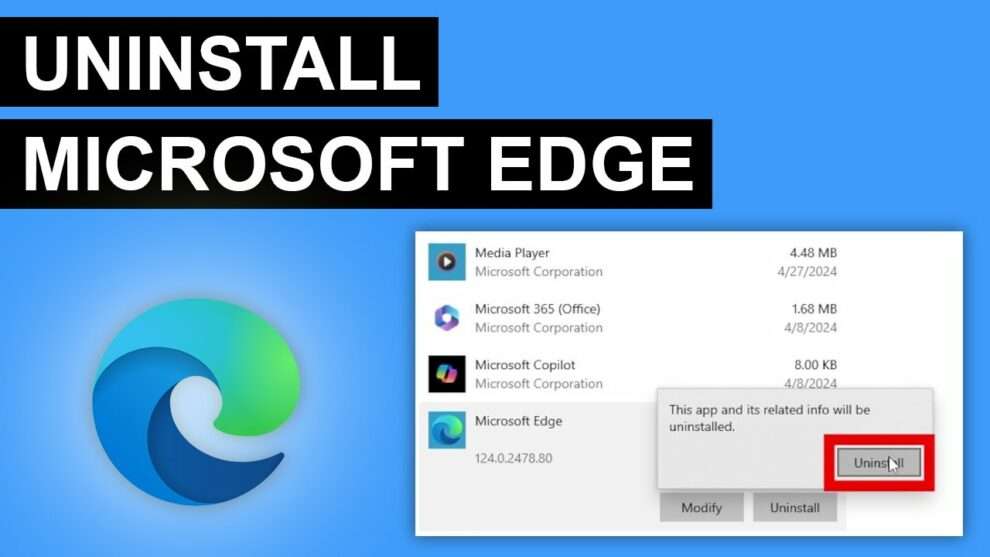Microsoft Edge, the tech giant’s flagship web browser, has been at the center of a quiet yet persistent controversy among Windows users. As Microsoft continues to integrate Edge deeply into the Windows operating system, users attempting to uninstall the browser have found themselves navigating a maze of obstacles. Microsoft’s subtle yet deliberate efforts to discourage the removal of Edge raise questions about user autonomy and corporate strategy in the software industry.
For many Windows 10 and 11 users, the desire to uninstall Edge stems from personal preference or a commitment to alternate browsers like Google Chrome, Mozilla Firefox, or others. However, Microsoft’s approach to Edge’s uninstallation process is anything but straightforward. Rather than providing clear instructions or a simple removal method, the company’s official channels often redirect users to promotional content highlighting Edge’s features, effectively sidestepping the user’s intent to remove the browser.
The Elusive Uninstall Option
Attempting to uninstall Edge through the conventional “Add or Remove Programs” interface in Windows yields limited results. Users quickly discover that the “Uninstall” button for Microsoft Edge is often grayed out or entirely absent. This design choice implies that Edge is an indispensable component of the operating system, even though alternative browsers can perform the same functions without issue.
Microsoft’s support pages offer little solace. Searches for “How to uninstall Microsoft Edge” frequently lead to pages that, rather than providing uninstallation steps, extol the virtues of Edge. These pages emphasize features such as enhanced security, seamless integration with Windows, and exclusive tools like vertical tabs, collections, and built-in coupon finders. While these features may be beneficial to some, they do not address the user’s original quest to remove the browser.
A Strategic Move or Heavy-Handed Tactics?
Microsoft’s reluctance to facilitate the uninstallation of Edge can be seen as a strategic effort to regain browser market share. Since the dominance of Internet Explorer waned in the face of competitors like Chrome and Firefox, Microsoft has been eager to re-establish its presence in the browser arena. By making Edge a core component of Windows and making its removal challenging, Microsoft ensures a higher user base by default.
However, this approach raises concerns about user choice and control over personal devices. In an era where customization and personalization are highly valued, obstructing the uninstallation process can be perceived as disregarding user preference. It brings to light a broader debate about the balance between a company’s strategic interests and consumer rights.
The Workarounds and Risks
Determined users have shared various methods to remove Edge from their systems. These often involve using command-line instructions in Windows PowerShell or Command Prompt, targeting the browser’s installation files directly. While these methods can be effective, they come with risks. Tampering with system files can lead to instability or unintended consequences within the operating system.
Tech communities and forums are replete with guides and cautionary tales from users who have attempted these workarounds. The necessity for such measures underscores the lengths to which users must go to exercise control over their software environment. It also highlights a gap in user-friendly solutions provided by Microsoft for those who, for legitimate reasons, prefer not to use Edge.
Microsoft’s Perspective
From Microsoft’s standpoint, integrating Edge deeply into Windows allows for optimized performance and security. The company argues that Edge is more than just a browser; it’s an integral part of the operating system that enhances user experience through features like Windows Search and integration with other Microsoft services.
Furthermore, Microsoft has invested heavily in developing Edge as a modern browser built on the Chromium engine, aiming to offer compatibility and performance on par with leading competitors. By encouraging users to stick with Edge, Microsoft is likely hoping to showcase these improvements and gradually change public perception that may still associate Microsoft’s browsers with the outdated Internet Explorer.
The Broader Industry Context
Microsoft is not alone in this practice. Tech companies often integrate their services tightly with their platforms to create a seamless ecosystem. Apple, for instance, pre-installs Safari on its devices, and while it can be bypassed, it remains the default browser in many respects. Google integrates its services across Android and Chrome OS, favoring its suite of applications.
However, the key difference lies in the ease with which users can opt-out or remove these default applications. The friction encountered when attempting to uninstall Edge is notably higher, which sets Microsoft’s approach apart and fuels the criticism it receives.
User Autonomy and the Future of Software Platforms
The situation with Microsoft Edge brings to the forefront the ongoing conversation about user autonomy in the digital age. As technology becomes more ingrained in daily life, the expectation that users have control over their devices intensifies. Software companies face the challenge of balancing their business objectives with the growing demand for transparency and flexibility.
Regulatory bodies have also taken an interest in such practices. Antitrust cases and legislation aimed at promoting fair competition and consumer rights could influence how companies like Microsoft design their software ecosystems in the future. Ensuring that users have the freedom to choose their preferred applications without undue difficulty may become not just a matter of goodwill but of legal compliance.
Alternatives and Recommendations
For users looking to minimize their interaction with Edge without resorting to risky uninstallation methods, setting a different default browser is a practical first step. Windows allows users to choose their preferred browser for web activities, which can redirect most tasks away from Edge.
Additionally, providing feedback to Microsoft through official channels can signal consumer sentiment. If enough users express their desire for an easier uninstallation process, it could prompt the company to reconsider its stance.
Microsoft’s handling of Edge’s uninstallation process reflects a complex interplay between corporate strategy and user freedom. While the company aims to promote its browser as a competitive and integral part of the Windows experience, users are advocating for greater control over their software choices. The difficulty in uninstalling Edge not only frustrates users but also raises important questions about the future of user autonomy in technology ecosystems.
As the dialogue between consumers and tech companies continues, finding a middle ground that respects user preferences while allowing companies to innovate and promote their products will be essential. Transparency and ease of customization could become key differentiators in a market where users are increasingly savvy and value control over their digital environments.
















Add Comment